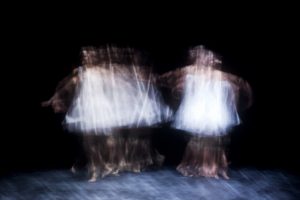Expanded ‘Afterlight’ grows dim

Dancers in Russell Maliphant’s Afterlight are blurred by lighting. Photo credit: Johan Persson
Russell Maliphant’s original Afterlight – an enthralling 15-minute solo inspired by images of Nijinsky, and first presented to commemorate the 100th anniversary of Diaghilev’s Ballet Russes – was a huge hit at Sadler’s Wells, London, in 2010.
In a new version, on view Thursday evening at Mandeville Auditorium, he retains that breathtaking solo, adds two lovely women, more hints of historic ballets, and lots of shadowy lighting. Sadly, the new material becomes flat and cannot compare to the hypnotic spell of the opening solo.
Set to Erik Satie’s haunting “Gnossiennes 1-4,”eyes strain to see Thomasin Gülgeç in a dim pool of light, dressed in a red shirt, his head covered by a white turban.
He spins and arches his muscled body so smoothly that one wonders if he is balanced on a spinning disk.
The blurry lighting design (by Michael Hull) obscures his face and casts curling lines on his limbs. Shadows and patterns flow over the stage.
Gülgeç’s dancing is remarkable, gripping and soft at the same time. Flickering light makes it all very ghostly – one can’t help but think of a locked-up Nijinsky suffering from schizophrenia. But look closer and you may recognize iconic poses from his youth, such as the shirtless slave in “Scheherazade.”
If only the rest of the work could be so beautifully sad.
The new sections are set to an electronic interpretation of Satie with plucks of strings and chimes that sound Asian.
Two women join Gülgeç in duets and trios, but they take their sweet time before touching each other. The movement trades circles for angled lines, but bodies are hidden in shadows.
At times, patterns glide over the stage to create the illusion of a flowing river. In the opening solo, lighting creates the claustrophobic sense of madness. Still, projections and animations too often overwhelm the dancing. Was the giant dappled scrim deliberately made to look like a giant slide of cancerous cells?
The women (Silvinia Cortes and Gemma Nixon) are lovely nymphs in white, and Gülgeç’s wilder energy conjures images of “Afternoon of a Faun.”
The dance is a rich tribute, and the women are pleasing dancers, but the extended work does not thrill in the same way as the magical opening. If you go, do not arrive late. And do not leave early. Maliphant rewards everyone with a gorgeous final image of Gülgeç whirling as a confined and desperate Dervish.

Kris Eitland covers dance and theater for Sandiegostory.com and freelances for other publications, including the Union Tribune and Dance Teacher Magazine. She grew up performing many dance styles and continued intensive modern dance and choreography at the Univ. of Minnesota, Duluth, and San Diego State Univ. She also holds a journalism degree from SDSU. Her career includes stints in commercial and public radio news production.
Eitland has won numerous Excellence in Journalism awards for criticism and reporting from the San Diego Press Club. She has served on the Press Club board since 2011 and is a past president. She is a co-founder of Sandiegostory.com. She has a passion for the arts, throwing parties with dancing and singing, and cruising the Pacific in her family’s vintage trawler. She trains dogs, skis, and loves seasonal trips to her home state of Minnesota.
